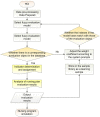Identification of psychological stressors in cancer patients based on a computer decision support nursing system
- PMID: 36398239
- PMCID: PMC9641483
Identification of psychological stressors in cancer patients based on a computer decision support nursing system
Abstract
Objective: We aim to improve the decision-making process of nursing evaluation, and the purpose of this paper was to introduce nursing outcome classifications based on standardized nursing language, as well as build a comprehensive nursing evaluation decision-making system model based on an artificial neural network and fuzzy comprehensive evaluations.
Methods: Based on the principle and method of the decision support system (DSS), this paper proposed a framework of DSS and developed an intelligent nursing decision support system which integrates expert systems, data, models and knowledge.
Results: Taking cancer patients as examples, based on the analysis and comparison of cancer stressors and their frequency of occurrence, this paper found that the 5 major factors for cancer patients' stress events were lack of privacy, attitude of the medical workers, unfamiliar medical workers and uncomfortable temperature in wards. In addition, through the single factor analysis of the stressors, it was found that "the impact of hospitalization on individuals and their families", "the professional level and service attitude of medical workers", and "partial loss of free social contact in the hospital" were all positively correlated with stress level. The degree of cancer patients' participation in treatment decision-making was lower than the expectation of the patients. There was a statistically significant difference between the actual participation and the anticipated participation of cancer patients in nursing decision-making (P < 0.0001). In addition, the system helped patients adapt to the hospital environment as quickly as possible, so that they could feel comfortable in the hospital environment, as well as a relaxed and pleasant with the humanistic environment.
Conclusion: Cancer patients have a variety of stressors, and the pressure is high. Our computer decision support nursing system assisted nurses to help patients to take positive coping measures to relieve pressure as soon as possible, so as to improve their quality of life.
Keywords: Decision support system; neural algorithm; pressure source; tumour patients.
AJTR Copyright © 2022.
Conflict of interest statement
None.
Figures








Similar articles
-
Promoting and supporting self-management for adults living in the community with physical chronic illness: A systematic review of the effectiveness and meaningfulness of the patient-practitioner encounter.JBI Libr Syst Rev. 2009;7(13):492-582. doi: 10.11124/01938924-200907130-00001. JBI Libr Syst Rev. 2009. PMID: 27819974
-
The future of Cochrane Neonatal.Early Hum Dev. 2020 Nov;150:105191. doi: 10.1016/j.earlhumdev.2020.105191. Epub 2020 Sep 12. Early Hum Dev. 2020. PMID: 33036834
-
Japan as the front-runner of super-aged societies: Perspectives from medicine and medical care in Japan.Geriatr Gerontol Int. 2015 Jun;15(6):673-87. doi: 10.1111/ggi.12450. Epub 2015 Feb 5. Geriatr Gerontol Int. 2015. PMID: 25656311
-
Does vicarious traumatisation affect oncology nurses? A literature review.Eur J Oncol Nurs. 2007 Sep;11(4):348-56. doi: 10.1016/j.ejon.2007.02.007. Epub 2007 May 7. Eur J Oncol Nurs. 2007. PMID: 17482879 Review.
-
Complexity science and participation in decision making among Taiwanese nurses.J Nurs Manag. 2008 Apr;16(3):291-7. doi: 10.1111/j.1365-2834.2007.00792.x. J Nurs Manag. 2008. PMID: 18324988 Review.
References
-
- Boyle DA, Bush NJ. Reflections on the emotional hazards of pediatric oncology nursing: four decades of perspectives and potential. J Pediatr Nurs. 2018;40:63–73. - PubMed
-
- Chambers SK, Hyde MK, Smith DP, Hughes S, Yuill S, Egger S, O’Connell DL, Stein K, Frydenberg M, Wittert G, Dunn J. New challenges in psycho-oncology research III: a systematic review of psychological interventions for prostate cancer survivors and their partners: clinical and research implications. Psychooncology. 2017;26:873–913. - PMC - PubMed
-
- Shanafelt T, Ripp J, Trockel M. Understanding and addressing sources of anxiety among health care professionals during the COVID-19 pandemic. JAMA. 2020;323:2133–2134. - PubMed
-
- Wade DM, Mouncey PR, Richards-Belle A, Wulff J, Harrison DA, Sadique MZ, Grieve RD, Emerson LM, Mason AJ, Aaronovitch D, Als N, Brewin CR, Harvey SE, Howell DCJ, Hudson N, Mythen MG, Smyth D, Weinman J, Welch J, Whitman C, Rowan KM POPPI Trial Investigators. Effect of a nurse-led preventive psychological intervention on symptoms of posttraumatic stress disorder among critically ill patients: a randomized clinical trial. JAMA. 2019;321:665–675. - PMC - PubMed
-
- Jadalla A, Ginex P, Coleman M, Vrabel M, Bevans M. Family caregiver strain and burden: a systematic review of evidence-based interventions when caring for patients with cancer. Clin J Oncol Nurs. 2020;24:31–50. - PubMed
LinkOut - more resources
Full Text Sources
